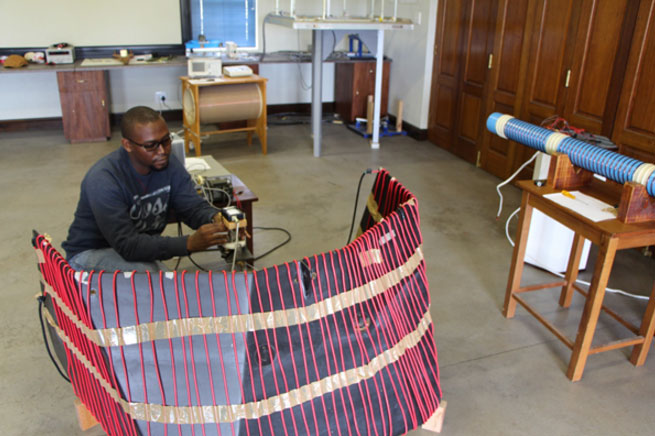
28 Mar Navigate sky and sea through ‘demagnetisation’
From helping marine vessels avoid explosive sea mines, to assisting aircraft find their way through the Earths magnetic field, SANSA’s Applied Science and Technology (AST) unit uses its unique expertise to demagnetise and calibrate. A division of SANSA, AST has been the true North of South African navigation for decades.

SANSA’s Applied Science and Technology (AST) unit works with the South African Navy to ensure their vessels are demagnetised to avoid triggering explosive sea mines.
The AST unit consists of a small team of experts who help clients integrate magnetic sensors into their systems. Such sensors include the simplest magnetic sensor of all, the humble compass which can be found in any aircraft or marine vessel. These vehicles are made from magnetic materials and accumulate additional magnetism by travelling through the Earth’s magnetic field, which affects compass readings. The SANSA team provides unique services and expertise to help clients compensate for this magnetism.
SANSA also provides training for the armed forces, helping them navigate the concept of magnetism so they can perform compass calibrations themselves. International safety regulations require that there be mechanical compasses on board all aircraft and marine vessels, in addition to the more modern GPS systems with electronic compasses, so this makes such a facility all the more relevant.
For the compass calibration service, SANSA provides training to help the local aviation industry perform aircraft compass swings; a procedure where the magnetism of the aircraft is measured and calculated and the aircraft’s compass is adjusted accordingly.
Completing the same process for a marine vessel is oceans apart from being as easy. The first hurdle being that a ship cannot be placed in an open field on land, and placing an external reference point at specific angles at sea is almost impossible, as the vessel constantly pitches and rolls. Currently there are very few marine compass adjusters in Southern Africa with the necessary skills to perform such compass calibration for marine vessels.
It is for this reason that the South African Navy is working with SANSA to train more qualified marine compass adjusters in South Africa, through an accredited Australian company that provides correspondence courses. The SANSA team is currently supporting experienced officers with the course material, which is challenging even for the experts in the field.
Reducing the magnetism of a marine vessel is vital as it can trigger active sea-mines that can still be found in certain places at sea. Thus, it is in the interest of the South African Navy to measure and manage the magnetic signature of their vessels.
Vessels are treated magnetically at a degaussing measurement facility, where the deperming of marine vessels and other systems is achieved by wrapping the whole object in copper coils and using high currents in a specific procedure to reduce the magnetism of the object. The SANSA team assist with this management of magnetic signatures.
The facility dealt with a recent case where a small vessel had highly magnetised component onboard, which protects the vessel against small arms fire. Due to the high level of magnetism of the component the compasses could not be correctly calibrated, which would affect navigation at sea. The process of deperming requires solid knowledge of physics and mathematics, but according to AST Manager, Danie Gouws, experience plays an even greater role. The experience boils down to understanding how different materials get magnetised and demagnetised through a material property called permeability. Understanding this property allows Danie and his team to correctly apply the external magnetic field needed to deperm the material.
The deperming process of vessels and other platforms are usually conducted on an annual basis but sometimes a platform can get magnetised so quickly that more regular deperming is needed. Factors such as heat, vibration, corrosion and lightning strikes can accelerate the rate at which a deperming is again needed.
Overall, the deperming procedure makes a significant contribution to the country’s safety and security. The services of SANSA’s AST unit will prove valuable to both the public and private sector for the foreseeable future.



